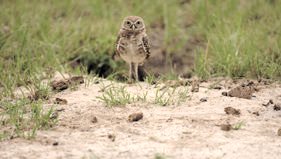Owls use dung to lure beetles
A burrowing owl spreads dung around its nest to attract beetles.
By Emily Sohn
You learn when you’re young that every activity has its place. You eat in the kitchen. You go to the bathroom in the bathroom. And never should you confuse the two. Owls have different rules, and now scientists have an idea why.
 |
|
A burrowing owl spreads dung around its nest, attracting beetles.
|
| R. Wolfe |
Burrowing owls collect the dung of cows and other mammals, and they bring the waste patties to their nests in the ground. Birdwatchers have noticed this for a long time. They’ve also noticed that if the dung disappears from the burrow early in the breeding season, the birds will replace it. Why they do this has been a mystery.
To solve the puzzle, scientists from the University of Florida in Gainesville tested several theories. One idea was that the smell of the dung overpowered the smell of eggs. That might keep predators away. In a test with fake burrows, however, predators were equally attracted to lairs with and without dung.
Next, the researchers set up traps with dry dung as bait. Other traps had moist dung, as if there had been a heavy rain. In both cases, the dung attracted dung beetles, though the wet dung attracted more. Owls like to eat beetles. So, maybe the dung was working as bait, like worms on a fishing rod.
For the final test, the researchers observed 10 burrows over 4 days. When they took the dung away from a burrow’s entrance, the owls had few beetles to eat. When the researchers added dung, the birds ate 10 times as many beetles.
The scientists propose that the owls use dung like a tool to attract beetles to eat. It’s not something you would want to try at home. But for the birds, it seems to work.







